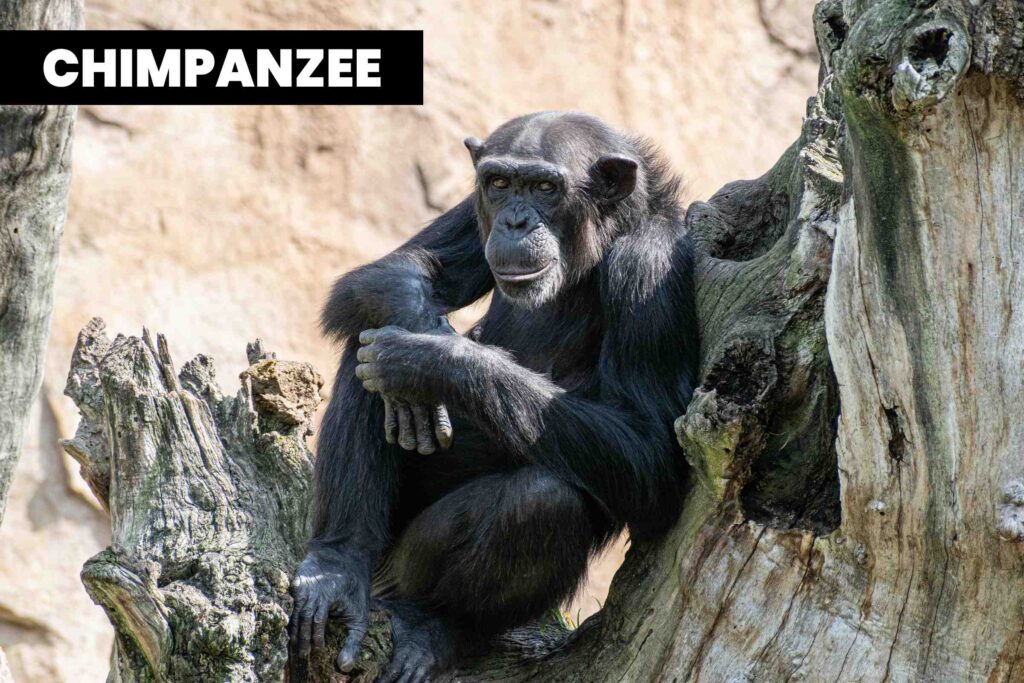
Chimpanzee: The Great Ape of Africa
The chimpanzee (Pan troglodytes), often colloquially referred to as the “chimp,” stands as one of the most fascinating species in the great ape family.
Native to the tropical forests and savannas of Africa, chimpanzees are not only closely related to humans but also share a striking array of behavioral, social, and cognitive traits with us.
The species is composed of four recognized subspecies, with ongoing research suggesting the possibility of a fifth.
Chimpanzees, alongside their close relative the bonobo, form the genus Pan. Both species are considered the closest living relatives to humans, with their evolutionary paths diverging from ours around six to eight million years ago.
Chimpanzees are renowned for their intelligence, complex social structures, tool usage, and ability to communicate.
Despite these remarkable traits, they are facing severe threats to their survival, primarily due to habitat destruction, poaching, and disease.
This article explores the biology, behavior, social structures, and conservation status of chimpanzees, providing a detailed understanding of what makes these great apes so unique and vital to the world’s biodiversity.
Etymology and Taxonomy
The term “chimpanzee” is derived from the Vili language of the Congo, where the word “ci-mpenze” or “chimpenze” means “ape.”
The English usage of the word first appeared in 1738, and by the late 19th century, the shortened form, “chimp,” had become a common colloquialism.
In scientific classification, chimpanzees belong to the genus Pan, which is shared with bonobos.
The species name troglodytes was coined by Johann Friedrich Blumenbach in 1775, inspired by the mythical race of cave-dwellers known as the Troglodytae.
Chimpanzees are classified as part of the family Hominidae, also known as the great apes, which includes humans, gorillas, and orangutans.
Within the genus Pan, the chimpanzee is distinguished from the bonobo by its larger size and more robust build.
Evolutionary History
Chimpanzees and humans share a common ancestor that lived approximately six to eight million years ago.
This divergence marks the point at which the lineage leading to modern humans split from that of chimpanzees and bonobos.
Fossil evidence of chimpanzees is relatively rare, as their remains tend to decompose quickly in tropical environments.
However, fossilized chimpanzee teeth found in East Africa suggest that members of the Pan genus lived in the region during the Middle Pleistocene, a time when early humans were also present.
Genetic studies have further illuminated the evolutionary relationship between chimpanzees, bonobos, and humans.
Chimpanzees and bonobos diverged from each other approximately two million years ago, with bonobos inhabiting areas south of the Congo River, and chimpanzees occupying territories to the north.
Despite their close evolutionary ties, the two species exhibit significant differences in behavior and social structures, with bonobos being more peaceful and matriarchal compared to the more hierarchical and sometimes aggressive chimpanzee societies.
Physical Characteristics
Chimpanzees are robust, muscular primates with a body covered in coarse black or dark brown hair. They have bare faces, ears, fingers, toes, palms, and soles, with their skin color ranging from pale to dark depending on the subspecies and individual age.
Adult male chimpanzees weigh between 40 and 70 kilograms (88–154 pounds), while females are slightly smaller, weighing between 27 and 50 kilograms (60–110 pounds).
They stand around 150 centimeters (4 feet 11 inches) tall, although in rare cases, some individuals may grow taller or heavier, especially in captivity.
Chimpanzees possess long arms, which are longer than their legs, enabling them to swing efficiently from tree branches in a form of locomotion known as brachiation.
Their hands and feet are adapted for grasping, with opposable thumbs and big toes, allowing them to manipulate objects and tools with precision.
Their faces are expressive, with a pronounced brow ridge and forward-facing eyes that give them excellent depth perception.
Behavior and Social Structures
Chimpanzees live in highly complex social groups known as communities, which can range in size from 15 to more than 150 individuals.
These communities operate under a fission-fusion dynamic, meaning that the members of the group frequently split into smaller subgroups for activities such as foraging or hunting, and then come together again later.
This fluid social structure allows for flexibility depending on the availability of resources and the social needs of the individuals.
At the core of chimpanzee society is a strict male-dominated hierarchy. The alpha male enjoys the highest status within the group, often maintaining his position through displays of aggression, forming coalitions with other males, and winning the support of key females.
However, dominance is not solely determined by physical strength; intelligence, social alliances, and political maneuvering also play crucial roles in maintaining rank.
Males often form coalitions to improve their standing or challenge a dominant individual.
Females, while generally subordinate to males, play critical roles in the social fabric of the community.
They are responsible for raising offspring and often form close bonds with other females. Female chimpanzees tend to emigrate to neighboring communities when they reach sexual maturity, a practice that helps reduce the risk of inbreeding.
Chimpanzees communicate through a combination of vocalizations, facial expressions, and body postures.
One of their most well-known vocalizations is the “pant-hoot” call, a loud, rhythmic sequence of hoots used to signal excitement, alert others to food sources, or coordinate group movements.
Their facial expressions are highly expressive, conveying emotions such as fear, aggression, submission, and playfulness.
Tool Use and Intelligence
Chimpanzees are renowned for their intelligence, particularly in their use of tools. They are one of the few non-human species known to create and use tools in the wild.
This behavior was first documented by primatologist Jane Goodall in the 1960s, when she observed chimpanzees in Gombe Stream National Park using sticks to “fish” for termites from mounds.
Since then, researchers have documented a wide range of tool use among chimpanzees, including the use of rocks to crack open nuts, modified leaves as sponges to soak up water, and sharpened sticks to hunt small mammals.
Chimpanzees’ ability to use tools is not only a testament to their intelligence but also demonstrates a remarkable capacity for cultural transmission.
Tool use varies between different chimpanzee groups, with some populations exhibiting distinct tool-making techniques and preferences.
This suggests that chimpanzees pass down knowledge from one generation to the next, much like human cultures do.
In addition to tool use, chimpanzees have demonstrated impressive problem-solving abilities, memory skills, and an understanding of basic concepts such as numbers and cause-and-effect relationships.
Studies conducted in controlled environments have shown that chimpanzees can recognize themselves in mirrors, indicating a level of self-awareness.
They have also been observed engaging in cooperative hunting, where multiple individuals work together to capture prey, and they are capable of sharing food with others, particularly close allies or offspring.
Diet and Feeding Habits
Chimpanzees are omnivorous, with their diet consisting primarily of fruit, but they also consume leaves, seeds, flowers, bark, and a variety of animal-based foods such as insects, honey, and small mammals.
Their feeding habits vary depending on the season and the availability of food within their habitat.
During times of fruit abundance, chimpanzees primarily focus on fruit consumption, but when fruit is scarce, they will broaden their diet to include other plant materials and occasionally meat.
Chimpanzees are known to hunt cooperatively, particularly for red colobus monkeys, which are a favored prey item.
Hunting parties, typically composed of males, work together to corner and capture the monkeys, with the meat being shared among the participants.
The sharing of meat is thought to strengthen social bonds and may also serve as a way for males to gain favors or form alliances with other group members.
Despite their reputation as hunters, animal prey constitutes a relatively small portion of the chimpanzee diet. Most of their nutritional intake comes from plant matter, particularly fruits.
However, their ability to adapt their diet to changing environmental conditions is one of the factors that have enabled them to survive in a wide range of habitats across Africa.
Reproduction and Parenting
Chimpanzees have a lengthy reproductive cycle compared to many other mammals. Females typically give birth to a single infant after a gestation period of about eight months.
Twins are rare. Newborn chimpanzees are entirely dependent on their mothers for survival, and the mother-infant bond is incredibly strong.
For the first few months of life, infants cling to their mother’s belly or back, relying on her for food, protection, and warmth.
Chimpanzee mothers provide extensive care for their young, nursing them for about three to four years before weaning.
Even after weaning, young chimpanzees remain close to their mothers for several more years, learning important survival skills such as how to forage for food, use tools, and navigate the social complexities of their community.
The mother’s status within the group can also influence her offspring’s future rank, particularly for males.
Females reach sexual maturity at around 11 to 13 years of age, while males mature slightly later, at around 13 to 15 years. Once females come into estrus, they exhibit prominent sexual swellings, signaling their fertility to males.
During this time, they may mate with multiple males within the community, a strategy that may help protect their offspring from infanticide by confusing paternity.
Threats and Conservation
Chimpanzees are currently listed as an endangered species on the International Union for Conservation of Nature (IUCN) Red List.
Their population has declined dramatically over the past few decades, with current estimates suggesting that between 170,000 and 300,000 individuals remain in the wild.
The primary threats to their survival are habitat destruction, poaching, and disease.
Habitat Loss
Habitat loss is the most significant threat facing chimpanzees today.
As human populations expand, forests are cleared for agriculture, logging, and infrastructure development, reducing the available habitat for chimpanzees.
Fragmented habitats make it difficult for chimpanzee populations to maintain genetic diversity and increase the likelihood of human-wildlife conflict.
Poaching
Although chimpanzees are protected by law in most of the countries where they are found, illegal hunting continues to pose a serious threat.
Chimpanzees are hunted for their meat, which is considered a delicacy in some regions, as well as for the illegal pet trade.
Infant chimpanzees are often captured for sale as pets, but the process of capturing them usually involves killing adult members of their group who try to protect the young.
Disease
Chimpanzees are also vulnerable to diseases, many of which are transmitted from humans.
As humans and chimpanzees share approximately 98.7% of their DNA, they are susceptible to many of the same diseases, including respiratory infections, Ebola, and other viral diseases.
Outbreaks of disease can devastate chimpanzee populations, particularly when combined with other threats like habitat loss and poaching.
Conservation Efforts
Efforts to conserve chimpanzees have been ongoing for several decades, with many organizations and governments working to protect their habitats and enforce anti-poaching laws.
National parks and protected areas have been established in several African countries, including Uganda, Tanzania, and the Democratic Republic of the Congo, where chimpanzees are found.
In addition to direct protection measures, public awareness campaigns aimed at reducing the demand for bushmeat and illegal pets have been launched to help curb the poaching of chimpanzees.
Conservationists are also working to promote sustainable land-use practices that can help minimize habitat destruction caused by agriculture and logging.
Protected Areas and National Parks
One of the most effective strategies for chimpanzee conservation is the establishment of protected areas, such as national parks and wildlife reserves.
These areas provide a safe haven where chimpanzees can live without the immediate threat of human encroachment, poaching, or habitat destruction.
Notable protected areas include Gombe Stream National Park in Tanzania, where Jane Goodall conducted her groundbreaking research, and Kibale National Park in Uganda, which is home to a significant population of chimpanzees.
However, these protected areas are not without challenges. Many of them are underfunded and understaffed, making it difficult to adequately enforce anti-poaching laws and monitor chimpanzee populations.
Additionally, the boundaries of these parks are not always respected, and illegal activities such as logging and hunting sometimes occur within their borders.
Conservation organizations are working with local governments to improve the management of these areas and ensure that they provide long-term protection for chimpanzees.
Community-Based Conservation
Recognizing that the future of chimpanzee conservation depends not only on protecting their habitats but also on working with the human communities that live near these habitats, many organizations have adopted community-based conservation approaches.
These initiatives aim to involve local people in conservation efforts by providing them with alternative livelihoods, education, and incentives to protect wildlife.
For example, in areas where chimpanzees are hunted for bushmeat, conservationists have introduced programs to promote sustainable agriculture or eco-tourism as alternative sources of income.
In other regions, education programs have been implemented to teach local people about the importance of chimpanzees to the ecosystem, with the hope that increased awareness will lead to better protection for the species.
Some organizations have also established health clinics and schools in rural communities, helping to build goodwill and fostering a greater sense of ownership over local conservation efforts.
By addressing the needs of human populations, these efforts aim to reduce the pressures that lead to habitat destruction and poaching.
Research and Monitoring
Ongoing research and monitoring are crucial to chimpanzee conservation. Researchers study chimpanzee behavior, genetics, and health to better understand their needs and the threats they face.
This information is essential for developing effective conservation strategies.
For example, genetic studies can help identify which populations are most at risk of inbreeding due to habitat fragmentation, while health studies can monitor the spread of diseases that could potentially decimate chimpanzee populations.
Field researchers also play a critical role in monitoring the status of wild chimpanzee populations.
By keeping track of population numbers, birth rates, and mortality rates, conservationists can assess the effectiveness of their efforts and adjust their strategies as needed.
In some cases, researchers have developed innovative techniques for monitoring chimpanzees, such as using drones to survey hard-to-reach areas and camera traps to document the presence of chimpanzees in remote habitats.
Rehabilitation and Sanctuary Programs
In addition to protecting wild populations, there are also efforts to rescue and rehabilitate chimpanzees that have been orphaned or captured for the illegal pet trade.
Sanctuaries provide a safe space for these individuals to recover and live out their lives in a more natural environment.
Some of these chimpanzees may eventually be reintroduced into the wild, although this is a complex process that requires careful planning and support.
Chimpanzee sanctuaries are often located in the countries where chimpanzees are native, and they play a vital role in raising awareness about the plight of the species.
Many sanctuaries also engage in public education campaigns, teaching visitors about the threats facing chimpanzees and the importance of conservation.
One of the most famous sanctuaries is the Tchimpounga Chimpanzee Rehabilitation Center in the Republic of the Congo, which was founded by the Jane Goodall Institute.
This sanctuary has provided care for hundreds of rescued chimpanzees and has been instrumental in advocating for stronger legal protections for great apes.
Human-Chimpanzee Relations
Chimpanzees have had a long and complex relationship with humans, marked by admiration, exploitation, and scientific curiosity.
As our closest living relatives, chimpanzees have been the subject of extensive research aimed at understanding human evolution, behavior, and cognition.
At the same time, their physical resemblance to humans has made them vulnerable to exploitation in the entertainment industry and the illegal pet trade.
Cultural Representations
In popular culture, chimpanzees have often been portrayed in a variety of roles, from comical figures in films and television shows to symbols of innocence and playfulness.
One of the most famous depictions of chimpanzees in Western culture was the “chimpanzee tea party,” a form of entertainment where chimpanzees were dressed in human clothing and made to perform in staged settings for the amusement of audiences.
These performances, while popular in the early 20th century, have since been criticized for their exploitation of the animals.
Chimpanzees have also appeared in literature and film as stand-ins for humans, often serving as a reflection of our own nature.
In the science fiction classic Planet of the Apes, chimpanzees are depicted as an intelligent species that has evolved to dominate the planet, a concept that challenges our assumptions about human superiority.
While such portrayals have contributed to the public’s fascination with chimpanzees, they have also led to misunderstandings about the true nature of these animals.
Chimpanzees are often depicted as docile or comical, when in reality they are complex, intelligent creatures with their own social dynamics and instincts.
Misleading portrayals can have negative consequences, such as encouraging people to keep chimpanzees as pets, despite the fact that they are wild animals with unpredictable behavior.
Chimpanzees in Research
Chimpanzees have played a significant role in scientific research, particularly in the fields of medicine, psychology, and evolutionary biology.
Their genetic similarity to humans has made them valuable subjects for studying diseases such as hepatitis and HIV, as well as for testing the safety of vaccines and other medical treatments.
However, the use of chimpanzees in medical research has been highly controversial.
Critics argue that it is unethical to subject such intelligent and sentient animals to invasive procedures, while proponents maintain that chimpanzees are necessary for certain types of research that cannot be conducted on humans.
In response to growing ethical concerns, many countries have enacted laws to limit or ban the use of chimpanzees in research.
In the United States, for example, the National Institutes of Health (NIH) announced in 2013 that it would retire most of its research chimpanzees and place them in sanctuaries.
This decision followed years of advocacy by animal rights groups, as well as scientific advancements that made it possible to conduct research without using chimpanzees.
Today, the use of chimpanzees in biomedical research is largely restricted, although some animals remain in laboratories for observational studies or other non-invasive research.
Chimpanzees as Pets
Despite their strength, intelligence, and unpredictability, chimpanzees have been kept as pets by some people, particularly in the United States.
Celebrities and wealthy individuals have been known to acquire chimpanzees as pets, often while the animals are still young and relatively manageable.
However, as chimpanzees mature, they become much more difficult to control, and their natural behaviors—such as aggression and territoriality—can make them dangerous to humans.
Chimpanzees are not domesticated animals, and their strong social instincts and need for complex interactions make it nearly impossible to meet their needs in a human household. In addition to the ethical concerns about keeping wild animals as pets, there are also practical dangers.
Adult chimpanzees are incredibly strong, with some estimates suggesting that they are up to five times stronger than humans.
This strength, combined with their sharp teeth and natural aggression, makes them capable of causing serious injury or even death if they feel threatened or frustrated.
Due to these risks, many countries have banned the private ownership of chimpanzees and other primates.
In the United States, for example, the Captive Wildlife Safety Act prohibits the interstate trade of chimpanzees as pets, and some states have enacted additional regulations to restrict private ownership.
The Future of Chimpanzees
The future of chimpanzees is uncertain. While significant progress has been made in protecting them from extinction, many challenges remain.
Habitat destruction continues at an alarming rate, and poaching and disease still pose serious threats to chimpanzee populations.
However, there are reasons for hope. Conservation efforts are expanding, with new protected areas being established and greater international cooperation in place to combat illegal wildlife trade.
Public awareness about the plight of chimpanzees is growing, and more resources are being directed toward their protection.
Additionally, research into chimpanzee behavior and genetics continues to provide valuable insights into their needs and vulnerabilities, helping conservationists design more effective strategies to protect them.
With continued support from governments, NGOs, and local communities, there is a chance that future generations will still be able to witness the incredible intelligence and social complexity of chimpanzees in the wild.
Final Note
Chimpanzees are one of the most remarkable species on our planet, sharing a deep evolutionary and biological connection with humans.
Their intelligence, social structures, and ability to use tools make them unique among non-human animals, but these same traits also make their exploitation and endangerment all the more tragic.
As we learn more about the inner lives of chimpanzees, it becomes clear that their survival is not just a matter of preserving biodiversity, but also of acknowledging and protecting the rights of these sentient beings.
The ongoing efforts to conserve chimpanzees offer a glimmer of hope, but they also serve as a reminder of the challenges we face in safeguarding the natural world.
The fate of chimpanzees is intertwined with the actions we take in the coming decades.
If we are to ensure that these incredible creatures continue to thrive in the wild, we must address the root causes of their decline—habitat destruction, poaching, and disease—and work together to create a future where humans and chimpanzees can coexist peacefully.
At Facts and Tips, we strive for accuracy and honesty. If you notice any errors, whether factual, editorial, or outdated information, please don't hesitate to contact us.






